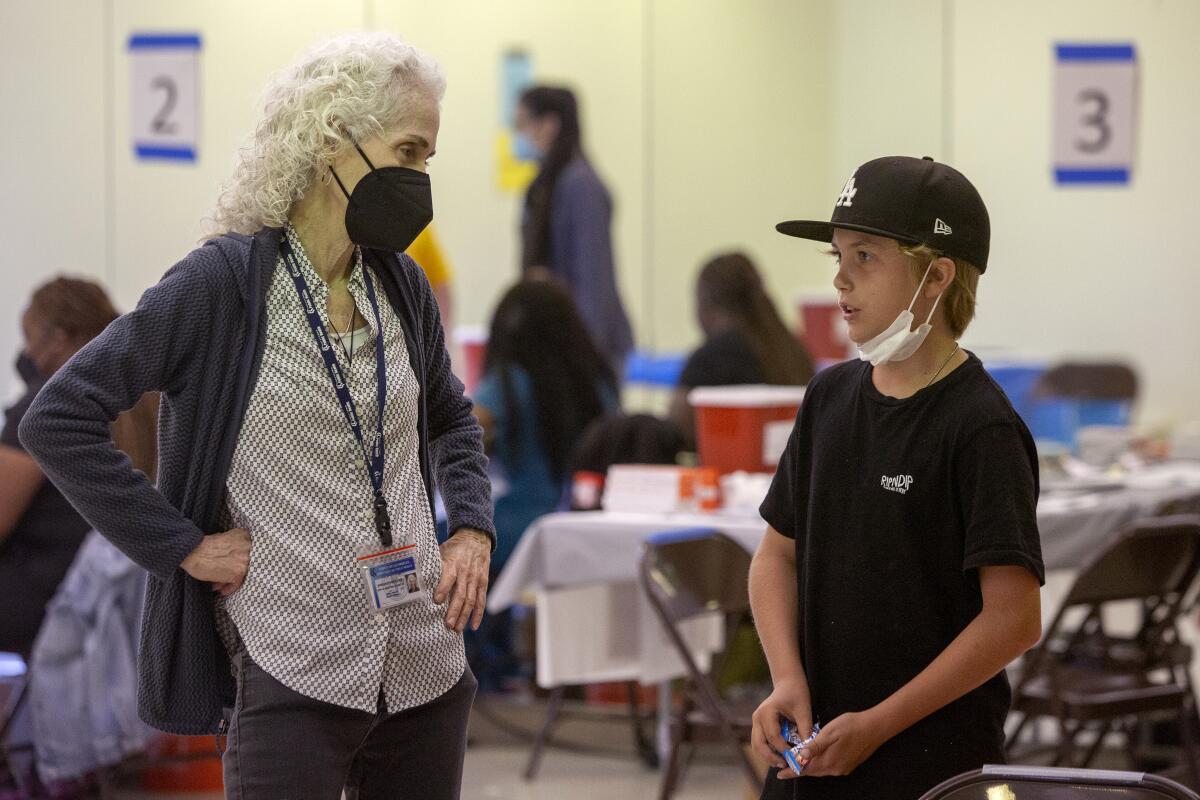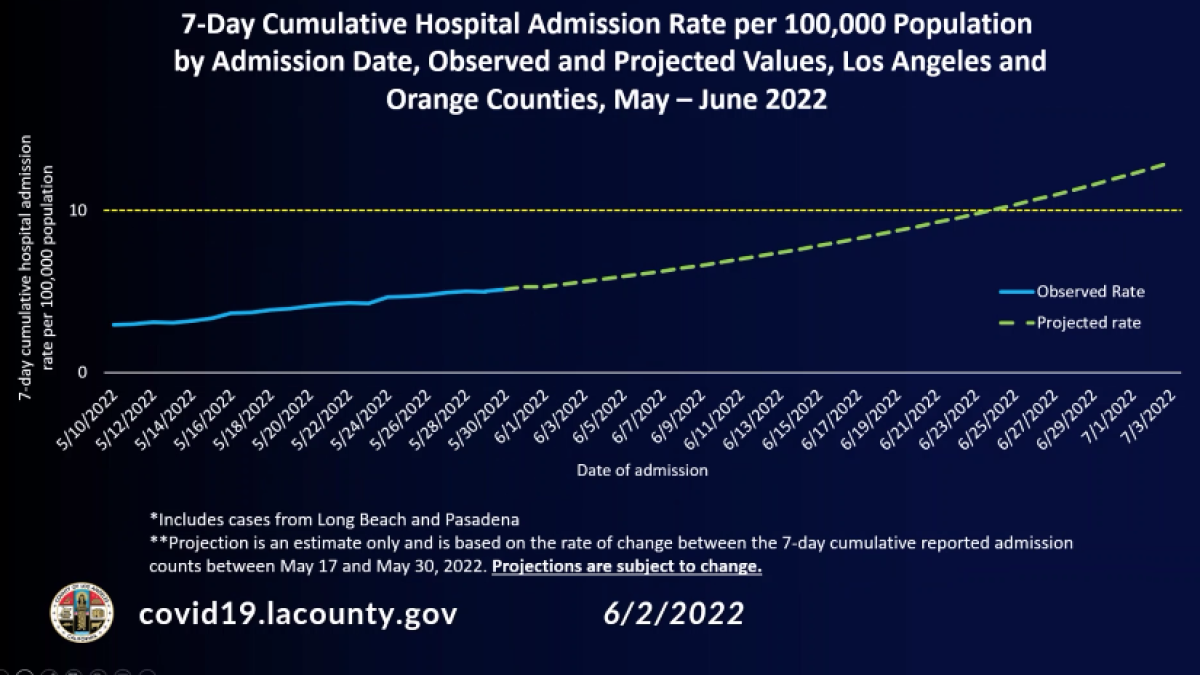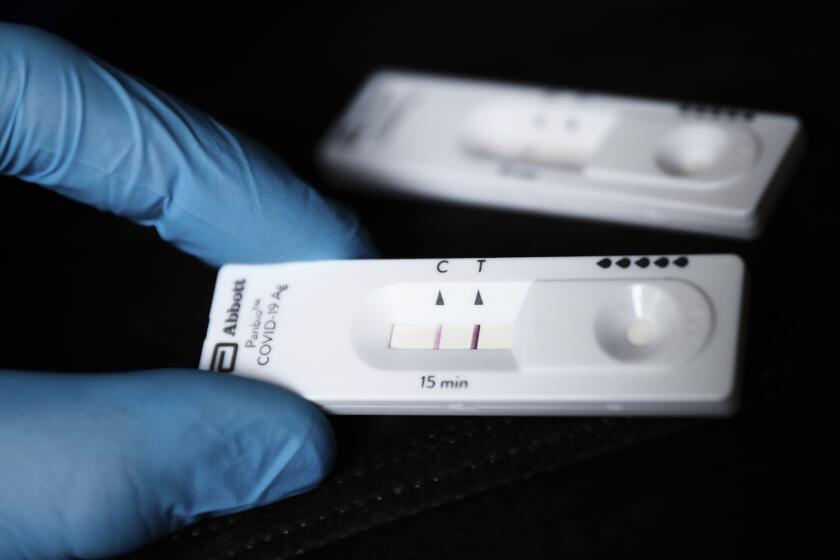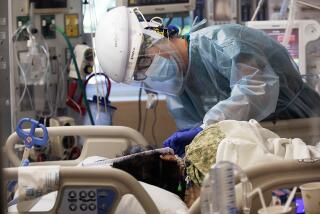L.A. County moves closer to possible mask requirement as coronavirus hospitalizations rise

With coronavirus-positive hospitalizations in Los Angeles County on the rise, officials said the nation’s most populous county could be poised to see a new universal indoor mask mandate later this month if the upward trends continue.
“Our weekly case rate and the rate of increase in hospital admissions are of concern,” L.A. County Public Health Director Barbara Ferrer said Thursday. “If we continue on the current trajectory … we’re likely to move into the CDC high [COVID-19] community level within a few weeks towards the end of June, indicating increased stress on the healthcare system.”
The concerns come as Alameda County, the Bay Area’s second-most populous county and home to Oakland, ordered a new mask mandate in most indoor spaces effective Friday, citing worsening coronavirus cases and rising rates of hospitalizations. That makes Alameda the first county in California to issue a universal indoor mask order since the end of the winter Omicron surge.
The U.S. Centers for Disease Control and Prevention recommends universal indoor masking when a county enters the high COVID-19 community level, the worst in a three-tier system.
Entering the high COVID-19 community level means that new weekly rates of hospitalizations, or hospital capacity, are being affected by coronavirus-positive patients to such an extent that the hospital systems may grow strained.
The CDC on Thursday placed 13 California counties in the high COVID-19 community level. It’s the first time since mid-March that any county in the state was in that level.
The Biden administration announced Tuesday that each U.S. household can order eight free at-home test kits, on top of the eight previously made available.
Nearly 1 in 6 Californians live in a county with a high COVID-19 community level. The affected counties are Santa Clara, Sonoma, Solano, Marin and Napa in the San Francisco Bay Area; Sacramento, Placer, Yolo, El Dorado in the Sacramento Valley area; and Monterey, Mendocino, San Benito and Del Norte elsewhere in Northern California.
In response to Sacramento County entering the high COVID-19 community level, the Sacramento City Unified School District on Thursday said it will reinstate an indoor classroom mask mandate effective Monday.
L.A. County health officials have already said once the county enters the high COVID-19 community level, that will trigger a local requirement to wear masks in indoor public settings.
Projections show L.A. County could enter the worst COVID-19 community level within three weeks, around the official start of summer.

“There is no certainty with this date. Actual hospital admission rates could increase at a faster rate. Or if case numbers stabilize or decrease in the next two weeks, the rate of increase in hospitalizations could be a lot lower,” Ferrer said.
“As we look to the near future, it reminds us that we ourselves also have the ability to influence where these numbers go. We all have the power to take steps to reduce the amount of viral spread, which ultimately reduces the number of people that are in the hospital with a positive COVID-19 infection,” Ferrer said.
According to CDC data issued Thursday, L.A. County observed 5.3 new weekly coronavirus-positive hospitalizations for every 100,000 residents, an 18% increase from the previous week’s rate of 4.5. A rate of 10 or more would place L.A. County in a high COVID-19 community level.
Elsewhere in Southern California, Ventura County had a new weekly coronavirus-positive hospitalization rate of 7.6; Santa Barbara County, 6.3; Orange County, 5.3; San Diego County, 4.9; and Riverside and San Bernardino counties, 2.9.
Sacramento and Placer counties had the highest weekly coronavirus-positive hospitalization rates in the state, 12.1; and other Bay Area counties also had high rates, with Sonoma and Marin counties reporting 11.8; Solano County, 11.5; Santa Clara and Monterey counties, 10.1; and San Francisco and San Mateo counties, 9.6.
Some trends in the San Francisco Bay Area point to a possible path where coronavirus-positive hospitalizations will worsen.
Alameda County’s rate of new weekly coronavirus-positive hospitalizations is 75% worse than L.A. County’s. Alameda County is reporting a rate of 9.3 weekly coronavirus-positive hospitalizations for every 100,000 residents, up 26% from the prior week, and the county’s health officer expects the area to enter the high COVID-19 community level soon.
Contra Costa and San Joaquin counties also had the same rate of new weekly coronavirus-positive hospitalizations as Alameda County.
“Daily new admissions of patients with COVID-19 rapidly increased in recent days and now exceed last summer’s peak,” the Alameda County Public Health Department said in a statement Thursday.
“Rising COVID cases in Alameda County are now leading to more people being hospitalized and today’s action reflects the seriousness of the moment,” Alameda County Health Officer Dr. Nicholas Moss said in a statement. “We cannot ignore the data, and we can’t predict when this wave may end. Putting our masks back on gives us the best opportunity to limit the impact of a prolonged wave on our communities.”
Alameda County has one of California’s highest coronavirus case rates — 354 cases a week for every 100,000 residents as of Monday. L.A. County’s rate is 299 cases a week for every 100,000 residents, according to data published Thursday. A rate of 100 cases or more a week for every 100,000 residents is considered high.
Initially, in this second wave of Omicron cases, communities that were traditionally hit hard by the pandemic weren’t disproportionately affected. But “that is no longer true,” Alameda County health officials said, and Latino residents now have the highest coronavirus case rate in Alameda County.
“Masking provides an added layer of protection against infection from a virus that spreads through the air. Wearing a high-quality mask protects both the wearer and those around them, and having more people masked will help slow the spread of COVID-19,” Alameda County health officials said.
The Alameda County mask order will require masks to be worn at indoor businesses and workplaces, including offices, stores, theaters and conference centers, as well as restaurants and bars when not eating or drinking; and on public transportation, including taxis and ride-shares, and at Oakland International Airport. Businesses and venue operators are required to post signage at all entrance points to communicate the mask requirement and “make reasonable efforts to ensure compliance in their setting,” the health order said.
Alameda County’s mask mandate has certain exceptions; the county won’t require masking in K-12 school settings through the few remaining days in the traditional school year, nor will the order apply to Berkeley, which has its own public health department. Masks need not be worn while working alone in a closed office or room; while swimming or showering at a gym; or while obtaining a medical or cosmetic service involving the head or face for which mask removal is needed to perform the service.
Alameda County is also allowing masks to be optional for performers at indoor live events, such as the theater, opera, symphony, religious choirs and professional sports; at religious gatherings when necessary to perform rituals; and at indoor gyms and yoga studios by people who are “actively engaged in periods of heavy exertion,” are swimming or diving, or when engaged in sports where masks create a risk to health, like wrestling and judo.
Masks will be required in other indoor youth settings, including child care, summer school and youth programs. Children younger than 2 must not mask because of the risk of suffocation.
The Berkeley public K-12 school system has already issued a mask order for indoor classroom settings, as well as indoor graduations. Other educational institutions have done the same elsewhere in California, including UCLA and Cal Poly San Luis Obispo.
Of all the COVID-19 restrictions that have been issued over the years, a mask order is among the least onerous to the public, said UC San Francisco epidemiologist and infectious-diseases expert Dr. George Rutherford.
“If you’re going to try and stay in front of this and try and restrict the damage that’s going on, this strikes me as a fairly low-level ask, to have people wear a mask,” Rutherford said.
“We’re not talking about lockdowns, we’re not talking about mandatory vaccination, we’re not talking about mandatory testing programs. We’re just talking about wearing masks, which are highly effective, especially if both people are wearing masks. And it’s something we’re used to doing,” Rutherford said.
In L.A. County and elsewhere, some hospital physicians have pointed out that many coronavirus-positive patients aren’t being treated in their hospitals for COVID-19, and their infection status is incidental to the reason they’ve been admitted.
In L.A. County, Ferrer said about 60% of coronavirus-positive patients in its public and private hospitals are being treated for reasons not related to the coronavirus infection, meaning only 40% of them are in the hospital because they’re sick with COVID-19 illness.
“But because they are COVID positive, they do create stress on the hospital system,” Ferrer said.
Too many coronavirus-positive patients in hospitals, whether they’re sick due to COVID-19 illness or for some other reason, strain resources because of the additional services the hospital needs to provide to keep the patients from spreading the virus to other vulnerable people.
More to Read
Sign up for Essential California
The most important California stories and recommendations in your inbox every morning.
You may occasionally receive promotional content from the Los Angeles Times.












